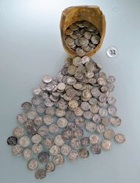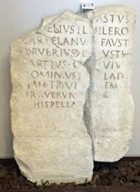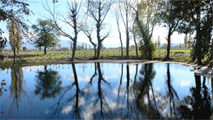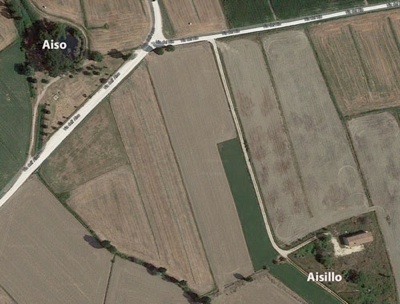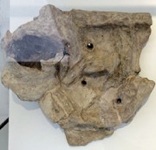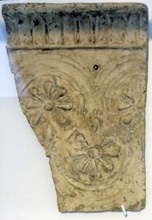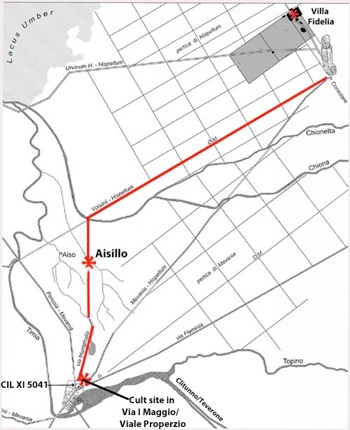Via I Maggio/ Viale Properzio
Laura Bonomi Ponzi (in A. Feruglio et al., referenced below, at pp. 87-90) described the results of excavations that were carried out in 1980-2 under a house in Via I Maggio (near the junction with Viale Properzio), an area that was probably just outside the Roman walls, uncovered finds from two distinct periods:
-
✴Those from the lowest level of the excavations came from what seems to have been an archaic settlement ( 7th century BC), which was described in the previous page.
-
✴Those from the level above came from a cult site formed by two pools or basins enclosed by walls and joined by a corridor some 16 meters long. This complex had apparently been monumentalised in two distinct phases:
-
•In the first phase, the earlier of the two pools was built in the south west corner of the complex. A number of ceramic votive objects found during the excavations date to this phase to ca. 200 BC.
-
•The cult site was extended and restored at the time of the Emperor Hadrian (117-38 AD). The upper levels of the first pool (above) and all of the second pool belong to this phase of development.
Coin Hoards
A hoard of some 230 coins, which included dateable coins from the period 211-110 BC, was found near the earlier pool. The coins were in a terracotta jar (also illustrated) that had been placed inside a wooden container and buried in a cavity some 800 cm below the ground. There is (apparently) no evidence that the coins had been accumulated over a long period: the older coins are (apparently) badly worn, and could well have been in circulation alongside the later ones. Thus, this seems to have been a case in which a number of coins were interred for safety, perhaps by the officials who administered the cult. The coins and their terracotta jar are now in the Museo Archeologico, Perugia.
A hoard of some 900 coins, which included dateable coins from the period 211-115 BC, was found outside Porta Foligno in 1929. Part of this hoard is displayed in the Museo Archeologico, Perugia. Unfortunately, the other part, which was exhibited locally, was later stolen.
Via Triumphalis
A paved road ran long the western side of the cult site in the SSW-NNE direction. According to Simone Sisani (referenced below, 2012, at p. 417), this road was:
-
“... paved with limestone slabs ...; [this material] is an important clue to its identification as the via triumphalis [known from an inscription], since the lapis Hispellas mentioned in [this] inscription alludes to that particular quality of limestone (pink or white) extracted from the quarries of Monte Subasio, near Spello” (my translation).
The inscription (CIL XI 5041) mentioned by Sisani is discussed in detail below. In summary, it records that:
viam triumphalem / straverunt lapide / Hispellate
the triumphal way was paved with stone from Spello.
The paving of the road was almost certainly undertaken by the priesthood of that Magistri Valetudinis: Simone Sisani (referenced below, 2012 at p. 416) dated the inscription on paleographic grounds to the start of the reign of Augustus (i.e. to ca. 27 BC), although the Eagle database (see the link above) gives a later date, the early 1st century AD.
Simone Sisani asserted (at p. 418) that:
-
“... the via triumphalis does not seem to bear any relationship to the surrounding urban centres. Moreover, its name refers explicitly to a road with purely religious associations and as such it probably connected Mevania not another city but at a sanctuary ... Recent excavations have ... identified a possible destination of the road, which is in fact exactly oriented exactly the Santuario dell'Aisillo, located about 2 km north of Bevagna in the heart of a complex of springs between the course of Timia and the artificial channel of the Topino” (my translation).
The implication was that, although this road was paved (or re-paved) in the early imperial period, it had probably had connected Mevania and the cult site in Vial Properzio to the sanctuary at the Laghetto dell’ Aisillo during an earlier period.
Suburban Sanctuaries
Lago dell’ Aiso
Lago dell’ Aiso
This image was supplied courtesy of Signor Giovanni Picuti
This freshwater lake, which has a diameter of 25 meters and a depth of 13 meters, is fed by an underwater spring at the centre of a vast aquifer under the plain between Bevagna, Cannara and Bastia Umbra. Its name derives from the Italian word for abyss, and it has remained a place of superstition well into modern times.
Bronze votive offerings (6th - 5th century BC) that were found here in the 18th century suggest that this was an ancient cult site that was probably devoted to a river god. Unfortunately, these important objects have been dispersed.
Laghetto dell’ Aisillo
Three even smaller ‘lakes’ near the Lago dell’ Aiso were documented in the early 20th century, each of which was identified by the diminutive “Aisillo”, followed by the name of the owner of the property on which it was found. Only one of these, documented then as the Aisillo Fanelli (on land that is now owned by the Lopparelli family) survives (in the location at the bottom right in the aerial view above): this is the so-called Laghetto dell’ Aisillo.
This circular lake, which has a diameter of about 5 meters and is surrounded by poplars, was excavated in 2004-5 and 2009-10, with results described by Matelda Albanesi and Maria Romana Picuti (referenced below). In its monumentalised form, the ‘lake’ was surrounded by a rectangular courtyard with a peripheral portico. The coins in the water here had probably had a votive function: the earliest of them dated to the 2nd century BC while the latest dated to the reign of the Emperor Diocletian (284 - 305 AD).
Simone Sisani (referenced below, 2012, at p. 418) reasonably suggested that the sanctuary had undergone at least two phases of monumentalisation:
-
✴one in the late Republican period, as evidenced by the architectural terracotta reliefs (2nd century BC) illustrated above (which are now in the Museo Archeologico, Perugia); and
-
✴another in the Augustan period, contemporary with the paving of the via triumphalis (above).
Other finds from the site include:
-
✴a number of architectural terracotta reliefs (early 2nd century BC);
-
✴a mosaic pavement (1st century BC) in one of the areas under the portico;
-
✴some fragmentary votive statues;
-
✴a silver head that might have represented the Empress Livia, perhaps in the mode of “Salus Augusta”, an iconography propagated by her son, the Emperor Tiberius, in 22 AD; and
-
✴a silver disc embossed with a relief of the deity Victory, which was probably a votive offering made by a soldier, perhaps in the reign of the Emperor Trajan (98 - 117 AD).
[Are they exhibited anywhere ??]
The remains of this sanctuary are now covered by about 2 meters of sediment, which suggests that it might have become unusable when failures in land management reduced the area to an impassable swamp. However, it is likely that the advent of Christianity in the area in the 4th century led to the abandonment of the site prior to its physical deterioration.
It is possible that the remains identified at the Lago dell’ Aiso and the Laghetto dell’ Aisillo originally belonged to a single sanctuary here. Thus Simone Sisani (at pp. 418-9):
-
“In ancient times, the entire area was probably the site of a complex of rural sanctuaries, where water clearly played a central role, significantly replicated at the opposite end of the via triumphalis by the system of water basins that articulated the sacred area of Viale Properzio. In both cases, the model for these sanctuaries was probably the sanctuary of Clitumnus, which Pliny vividly described as a series of springs, each of which had its own cult and its own temple.” (my translation).
An Association with the Cult of Valetudo ?
According to Simone Sisani (2012, referenced below, at pp. 418-9)
-
“The entire area [around the the Laghetto dell’ Aisillo and the nearby Lago dell’ Aiso] originally hosted a complex organic structure of rural sanctuaries, where water clearly played a central role that was significantly replicated, the opposite suburban end of the via triumphalis, in the system system of fountains that articulated the sacred area of Viale Properzio. ... the latest model for these sanctuaries is likely to have been the sanctuary at the source of the Clitumnus, which Pliny vividly described as a series of springs, each of which had its own cult and its own small temple. Since the source of the river and the eponymous god Clitumnus acted as ‘parens’ in relation to the other cults - according to the striking metaphor used by Pliny - then, in my opinion, the main deity worshiped in the sanctuary at the Laghetto dell’ Aisillo was Valetudo, as suggested, if by nothing else, then by the particular interest that the Magistri Valetudinis took in the processional route that was directed towards this sanctuary” (my translation).
He characterised Valetudo as the female ‘partner’ of Clitumnus/ Juppiter, in a form of religious association between male and female deities known in the areas of Rome/Lazio and Etruria. I discuss my reservations about this hypothesis in my page on Valetudo and the Magistri Valetudinis.
Ancient Processional Route from Mevania ?
Centuriation between Mevania and Hispellum
Adapted from Simone Sisani (referenced below, 2012, Figure 13)
See also, for example, Camerieri and Manconi (referenced below, 2012, Figure 16)
Simone Sisani (referenced below, 2012, pp. 417-8 and p. 428) traced the route of the via triumphalis, which (according to an inscription, CIL XI 5o41) was paved by the Magistri Valetudinis in the Augustan period: this route (illustrated above) left Mevania through a gate in the Roman walls to the north of the present Porta Cannara, and then:
-
✴traced a route that included a stretch of road apparently paved in stone from Spello that has been excavated along the western edge of the sanctuary on Viale Properzi to a sanctuary that has been excavated at the Laghetto dell’ Aisillo), which he suggested was dedicated to Valetudo (at in the Augustan period by the Magistri Valetudinis); and then
-
✴turned northeast to Hispellum and the sanctuary below it, at Villa Fidelia (at p. 428).
Read more:
P. Camerieri and D. Manconi , “Il ‘Sacello’ di Venere a Spello: dalla Romanizzazione alla Reorganizzazione del Territorio: Spunti di Ricerca ", Rivista di Antichità, 21 (2012) 63-80 S. Sisani, “I Rapporti tra Mevania e Hispellum nel Quadro del Paesaggio Sacro della Valle Umbra”,, in
G. Della Fina (Ed.), “Il Fanum Voltumnae e i Santuari Comunitari dell’ Italia Antica”, (2012) Orvieto (pp. 409-64)
M. Albanesi and M. R. Picuti, “Un Luogo di Culto d’ Epoca Romana all’ Aisillo di Bevagna (Perugia)”, Mélanges de l’École Française de Rome, 121 (2009) 133-179
A. Feruglio et al. (Eds), “Mevania: Da Centro Umbro a Municipio Romano”, (1991) Perugia
Ancient History: Pre-Roman Mevania Fonti del Clitunno
Mevania after the Conquest Sanctuary at Villa Fidelia before 41 BC Other Sanctuaries
Mevania after the Perusine War Valetudo and the Magistri Valetudinis
Return to the page on History of Bevagna.


